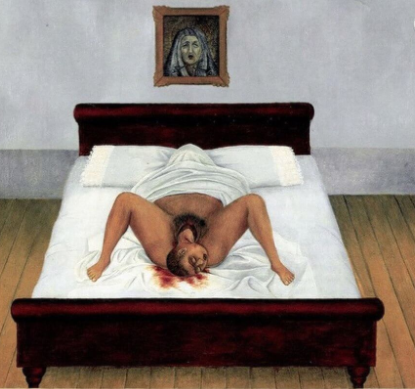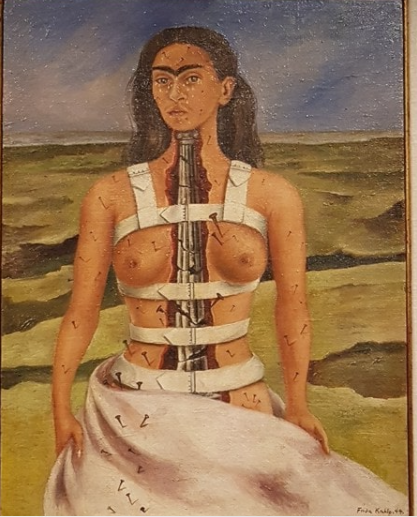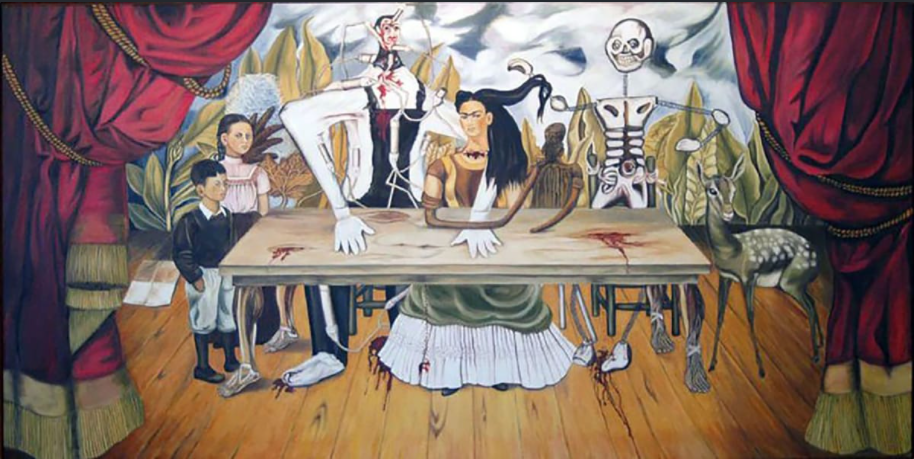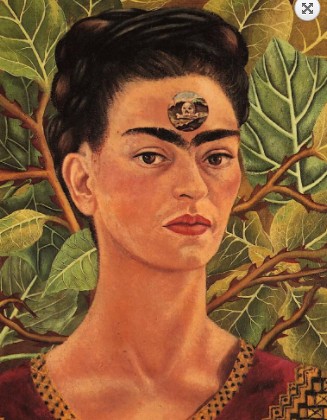Frida is the most significant Mexican artist whose art captivates various viewers. This essay describes more about Frida, including her The Broken Column, The Wounded Table, Thinking About Death, and My Birth paintings. She was a painter who used her art to express the physical and mental trauma she had experienced over her life. Frida Kahlo was born in the municipality of Coyoacán, just outside of Mexico City, on July 6, 1907, as the daughter of Mexican immigrants. Frida suffered physical disabilities due to polio during her brief life. An unfortunate bus accident at the tender age of 18 years changed the course of her career, and she decided to go into medicine instead. Frida learned to draw and paint as a result of this mishap. Self-portraits and exploration of Mexican folk culture and Aztec mythology were hallmarks of Frida Kahlo’s work, as were works that also straddled the line between reality and fiction. A pulmonary embolism killed her in 1954, yet other individuals believe she took her life.
When women were demanding a new role, they grappled with the cultural norms of their gender, which had an impact on Frida’s painting. She was a modern woman, but her art had a strong indigenous influence. Her preferred medium was self-portraiture, and she conveyed her thoughts on the world through this medium. Frida was an active participant in the global community and a loud voice for her ideals throughout her life through her work. Despite the controversy surrounding her work, she nevertheless managed to draw a large following. As a result of her work’s complexity and provocative nature, Frida has achieved worldwide attention. When it came to self-portraits depicting her innermost thoughts and feelings, she was fearless. Her beloved husband, Diego Rivera, pushed her to begin a series of paintings (“IN THE STUDY: Frida Kahlo’s Transformation of Retablo,” 2022). As a bridge-builder with her paintbrush, she comforted and reassured several, especially women, that they were not alone in their experiences or identities.
After suffering a miscarriage, Kahlo painted My Birth, her first painting that depicts how she imagined she was born. She described her artwork as her journal, which several people believe depicts the artist’s feelings and emotions about losing a child she never had. In Frida’s My Birth picture, her head gets more prominent in the womb until it emerges from the mother’s body. Because of the miscarriage, Frida’s mother’s body appears to be covered in a puddle of blood. The mother’s face is obscured by a sheet, which could represent a remnant of her mother’s recent death. The weeping “Virgin of Sorrows” portrait hangs above the birth bed. The Virgin weeps with sorrow and sympathy, but it appears she has little power to help (“IN THE STUDY: Frida Kahlo’s Transformation of Retablo,” 2022). The mother is not watching the birth because she is covered in a sheet and is virtually distancing herself from the event because it is too distressing and heightens this idea further.

To create a melancholy mood, both The Broken Column and My Birth pare down the detail to an absolute minimum. A painting adorns the wall above the bed in this bare-bones room. Frida is left with nothing but a thin sheet covering her lower abdomen as the only kind of defense left to her after the Fall of the Column. There may be an underlying theme of modest beginnings in My Birth, rather than any specific turbulence at this early stage of the artist’s existence. Against a lonely and disjointed backdrop, Kahlo paints herself as though she has been through as much turmoil and agony as the viewer does (“The Broken Column – Frida Kahlo – Google Arts & Culture,” 2022). Her almost unclothed physique has a profound and jagged gap that discloses her backbone as a devastated and broken Ionic nugget pillar to the spectator. All over her body and on her face are punctured by nails of varying lengths, adding to her misery.
Frida’s cheeks were flushed with tears as she recounted the events in her life. The painter later added a white surgical-looking sheet to conceal Kahlo’s bottom half, which was drawn initially nude save from the banded medical support corset she was wearing. Although her body was disfigured, her sensuality was still clearly visible in her breasts. The depiction of nails and sheets also evoked Christian martyrdom imagery; Kahlo’s visage is a picture of power and defiance (“The Broken Column – Frida Kahlo – Google Arts & Culture,” 2022). Even with her mutilated and tortured body, it is clear that her spirit was not broken. Her demeanor is consistent with how she has always approached life: forceful and defiant toward the observer. The piercings in her body caused by her nails depicted the persistent suffering Frida endured. Some of the scars on her left breast pertain to her loneliness, while others result from an accident in 1925 that left her scarred for life. Because she was often alone, Frida explained that she often depicted herself in her artworks because she was the only one who could relate to her.
Frida’s art depicts how she was full of tears and sorrow that bared her soul. Taking a closer look at Frida’s artwork, one could observe how the self-taught artist portrayed herself in the years leading up to her death. Frida Kahlo endured numerous traumas in her short life, but perhaps one of the most deadly and permanent happened when she was 18 (“The Broken Column – Frida Kahlo – Google Arts & Culture,” 2022). According to reports, Kahlo and her other passengers were in a car accident on their way home from school when their bus collided with another vehicle. A metal railing was impaled into her pelvic hip area, causing great pain and suffering. When she was admitted to the hospital, she was bedridden for a month, and she was subsequently confined to her home for several months. For this reason, she started creating a kind of broken woman art, which would help her deal with her grief and serve as an outlet for many other women who were going through similar hardships.

Frida purposively crafted The Wounded Table Picture work of art, around 4 x 8 feet in size, because it was scheduled to be presented at the same exhibition as Diego’s “cheating husband.” Kahlo painted this piece while she was going through a divorce from Diego Rivera, and her emotional state can be seen throughout the work. With Frida at the center of the table, this picture resembles a distorted version of the Last Supper (The Wounded Table, 2022). People from all walks of life circle her: A paper-mâché Judas, skeleton, pre-Columbian art and Cristina’s pet fawn Granizo are some of Cristina’s possessions. In her 1938 The Wounded Table painting The Four Inhabitants of Mexico City, all four characters, including a skeleton and an ancient Aztec statue, are depicted here.

Frida Kahlo’s right forearm was a stylized depiction of the form and color of the clay Nayarit number’s right arm. The Nayarit was held aloft by Frida’s cupped palm. Diego Rivera’s pre-Columbian collection is where this Nayarit couple started (The Wounded Table, 2022). It is safe to say that the Nayarit represents Mexico’s past and its people; Frida Kahlo is a Nayarit icon. Frida uses her blood to sustain this phantom: the blood that Frida drew from the gaping cut on her neck. Frida’s wounds have healed, and she has made the ultimate sacrifice for her Mexican father (Thompson, 2022). Frida Kahlo was severely injured in the bus accident, and the skeleton has remained unexplained for almost a century. Frida’s right foot was amputated in 1934, and the foot of the skeleton in her painting had a striking resemblance to that of Frida. Frida Kahlo never painted a skeleton with a round head, huge eyes, a genuine laugh, or a ribcage structure.
As with most of Frida Kahlo’s works, Thinking About Death portrays the artist herself. But it is a far cry from the stereotype of an artist that most people have in mind. She appears to be standing in front of a lush green backdrop, which recalls her tropical home in Mexico (“Thinking about death – by Frida Kahlo,” 2022). The abundance of vegetation also symbolizes life and renewal. In her portraits, Kahlo is shown with her shoulders back and her neck straight, as if she is gazing peacefully and directly into the camera. In Frida’s Thinking About Death portrait, she appears to have died “on her mind” at all times. As a crack into her thoughts or expression of her facial features, the circular photo is a permanent part of her self-image (“Thinking about death – by Frida Kahlo,” 2022). The perfect circle in the middle of her forehead depicts a rural scene with a skull and crossbones.

A lifetime of physical agony and disease, as well as a few near-death experiences, were a constant reminder of her death. The unwavering expression on Kahlo’s face shows boldness, despite the artist’s constant contemplation of her mortality. Kahlo depicted an acceptance of pain and death as part of life. She says that individuals can live a happy life even if they know their mortality and do not let it overwhelm them. Death was a constant concern in her head due to her deteriorating health. The skull and crossbones on her forehead signify a death in the picture. Death is also a harbinger of rebirth and a new beginning in the ancient Mexican tradition. Symbolic of life, she placed herself in front of a backdrop of lush green leaves. It appears that Frida had a deep understanding of death as a stepping stone to a new kind of existence.
A physician’s study of Frida Kahlo’s life and art can help them better understand pain’s suffering and dehumanizing effects. Paintings by Frida convey suffering and its influence on human life. In Kahlo’s paintings, one can see the anguish, loss, and confusion of the patient’s perspective, and readers can reflect on their experiences of pain in the process. A doctor’s duty necessitates far more than just diagnosing, treating, and educating patients. Therefore, pain is a complex occurrence that impacts several facets of life.
References
The Broken Column – Frida Kahlo – Google Arts & Culture. Google Arts & Culture. (2022). Web.
In the Study: Frida Kahlo’s Transformation of Retablo. Society for the Arts in Religious and Theological Studies. (2022).
Thinking about death – by Frida Kahlo. Fridakahlo.org. (2022).
Thompson, Z. (2022). Still Devouring Frida Kahlo: Psychobiography versus Postcolonial and Disability Readings. Ebooks.ohiolink.edu.
The Wounded Table, 1. (2022). Frida Kahlo – The Wounded Table, 1940. Arthur.